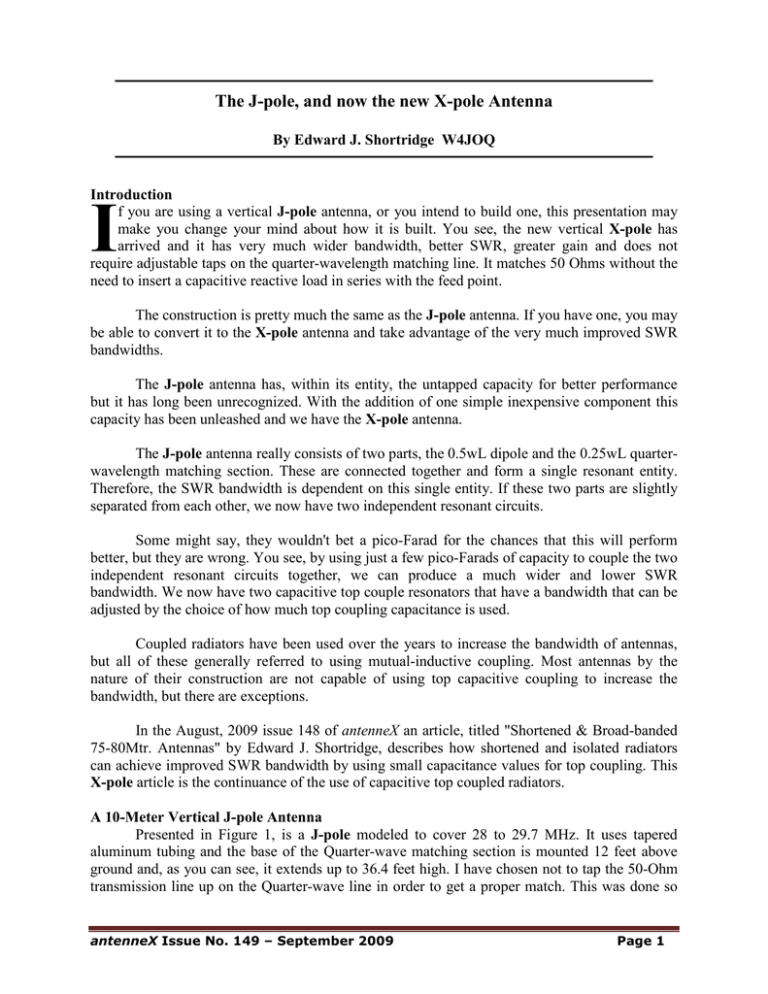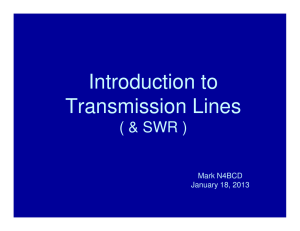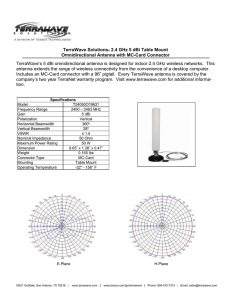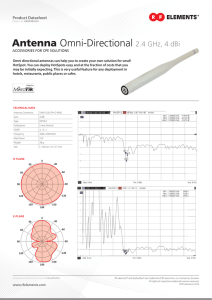
The J-pole, and now the new X-pole Antenna
By Edward J. Shortridge W4JOQ
Introduction
f you are using a vertical J-pole antenna, or you intend to build one, this presentation may
make you change your mind about how it is built. You see, the new vertical X-pole has
arrived and it has very much wider bandwidth, better SWR, greater gain and does not
require adjustable taps on the quarter-wavelength matching line. It matches 50 Ohms without the
need to insert a capacitive reactive load in series with the feed point.
I
The construction is pretty much the same as the J-pole antenna. If you have one, you may
be able to convert it to the X-pole antenna and take advantage of the very much improved SWR
bandwidths.
The J-pole antenna has, within its entity, the untapped capacity for better performance
but it has long been unrecognized. With the addition of one simple inexpensive component this
capacity has been unleashed and we have the X-pole antenna.
The J-pole antenna really consists of two parts, the 0.5wL dipole and the 0.25wL quarterwavelength matching section. These are connected together and form a single resonant entity.
Therefore, the SWR bandwidth is dependent on this single entity. If these two parts are slightly
separated from each other, we now have two independent resonant circuits.
Some might say, they wouldn't bet a pico-Farad for the chances that this will perform
better, but they are wrong. You see, by using just a few pico-Farads of capacity to couple the two
independent resonant circuits together, we can produce a much wider and lower SWR
bandwidth. We now have two capacitive top couple resonators that have a bandwidth that can be
adjusted by the choice of how much top coupling capacitance is used.
Coupled radiators have been used over the years to increase the bandwidth of antennas,
but all of these generally referred to using mutual-inductive coupling. Most antennas by the
nature of their construction are not capable of using top capacitive coupling to increase the
bandwidth, but there are exceptions.
In the August, 2009 issue 148 of antenneX an article, titled "Shortened & Broad-banded
75-80Mtr. Antennas" by Edward J. Shortridge, describes how shortened and isolated radiators
can achieve improved SWR bandwidth by using small capacitance values for top coupling. This
X-pole article is the continuance of the use of capacitive top coupled radiators.
A 10-Meter Vertical J-pole Antenna
Presented in Figure 1, is a J-pole modeled to cover 28 to 29.7 MHz. It uses tapered
aluminum tubing and the base of the Quarter-wave matching section is mounted 12 feet above
ground and, as you can see, it extends up to 36.4 feet high. I have chosen not to tap the 50-Ohm
transmission line up on the Quarter-wave line in order to get a proper match. This was done so
antenneX Issue No. 149 – September 2009
Page 1
that a good comparison can be made to the X-pole antennas. The source
impedance at wire 6 was measured at 26 Ohms and series-section matching
was used to achieve a match to a 50-Ohm source. The Quarter-wavelength
matching section, wires 4 and 5, are spaced 8.9 inches apart which will be
close to that of the X-pole antennas to be presented later.
Figure 2 shows the lengths and diameters of
each of the conductors. The diameters of these
conductors can be altered somewhat without much
change in the antenna performance. Figure 3 shows
the far-field radiation pattern for this antenna.
Please note that the antenna has a maximum gain of
2.8 dBi, which we will later compare to the X-pole
antennas.
Figure 2
Figure 3
Figure 4 shows an SWR plot across the entire 10-Meter bandwidth
and as you can see, the SWR readings are almost 3/1 at the band edges.
This would be considered inadequate for good operation. The gain of this
antenna is shown as 0.77 dBi in one direction and 1.76 dBi in the other
direction.
Figure 1
The Mast support wire 7,
as shown in Figure 1, is in line
with wire 4 and this is a normal
configuration for this antenna.
But, if we moved the Mast to
where it is in line with wire 5, the
RF currents on the Mast are
Figure 4
greatly reduced. And, the gains at
low angles of far-field radiation are improved from 0.77 dBi in one direction and 1.76 dBi in the
other direction, to 1.57 dBi in one direction and 2.47 dBi in the other direction. The maximum
antenneX Issue No. 149 – September 2009
Page 2
gain of 2.8 dBi as shown in Figure 3 has not changed. Although this might not be the best
physical support for the antenna, it certainly is the best position for best low angle radiation
gains.
In order to compare this SWR bandwidth with that of an isolated 0.5wL Dipole at the
same height above ground, the Quarter-wavelength matching section wires 4, 5, and 6 were
removed and a 72-Ohm center-fed source was used. The SWR scanned bandwidth is shown in
Figure 5, and as you can see the 1.5/1 SWR is far better than that of Figure 4. The assumption is
that the poor SWR of the J-pole is due to the Quarter-wavelength matching section.
Figure 5
In order to verify this contention, the Quarter-wavelength line impedance was calculated
to be 380 Ohms. When the 26-Ohm impedance at wire 6 is divided into 380, this produces a
figure of 14.616. If this is multiplied by the 380-Ohm’s line impedance, the calculated
impedance at the top end of the Quarter-wavelength line is indicated to be 5554 Ohms
When 26-Ohm source impedance is modeled feeding a 380-Ohm Quarter-wavelength
transmission line and that line is terminated with a 5554-Ohm load, the SWR characteristics of
that line can be plotted, as shown in Figure 6. As you can see, the SWR is almost 2/1 at the band
edges and accounts for the big difference in the SWR between Figures 3 and 4. There are certain
inaccuracies here because, in actual practice, the 5554 Ohms that was calculated was only
accurate for the center of the bandwidth, but the results are fairly accurate.
Figure 6
What this indicates is that a 0.5wL vertical Dipole radiator fed by a different means could
have a superior SWR compared to that of the J-pole antenna. This is where the design of the Xpole antenna really begins to show its advantages in the SWR improvement.
antenneX Issue No. 149 – September 2009
Page 3
A 10-Meter Vertical X-pole antenna covering 28 to 29.7 MHz
This antenna, as shown in Figure 7, was modeled to be very close to
that of the J-pole antenna. As far as the tubing sizes, the spacing between
wires 4 and 5, this is shown in Figure 8. Even though the spacing is the
same, the source impedance at wire 6 matches 50 Ohms. So what made the
difference? Well, if you look closely, you will find that a 6 pF capacitor was
inserted in series at the bottom end of the wire 2 Dipole where it connects to
the Quarter-wavelength matching section wire 4. The lengths of wires 1, 4
and 5 are all considerably shorter than those of the J-pole and had to be
adjusted for the best SWR across the bandwidth.
All of the X-pole antennas being discussed have their Mast in-line
with wire 5, and not wire 4, which connects to the radiator wires 1, 2 and 3.
This was done in order to keep the currents on the Mast at a minimum so that
the gains at low angles of radiation do not suffer.
28-29.7MHZ 50ohm X-Pole
Figure 8
Wire# Length Dia.od
1
3.3"
0.375"
2
84.2" 0.50"
3
84.2" 0.625"
4
92.5" 0.75"
5
92.5" 0.75"
6
8.9"
0.75"
Figure 7
The far field radiation pattern for this antenna is shown in Figure 9 and, as you can see, it
has a maximum gain of 3.17 dBi compared to 2.81 dBi for the J-pole antenna. By the simple acts
of inserting a small inexpensive 6 pF capacitor and changing the length of a few conductors by a
few inches, we now have an X-pole antenna that needs no additional matching, such as the Jpole required.
Figure 9
antenneX Issue No. 149 – September 2009
Page 4
The most substantial and outstanding improvement is with the SWR across the entire 28
to 29.7 MHz band. As shown in Figure 10, it is almost flat at a SWR of 1.1/1. There aren't many
antennas that can duplicate a SWR this good. If you look back at Figure 4, the SWR for this
basic 0.5wL dipole is up to 2/1 at the band edges. The SWR bandwidth display for the J-pole
antenna, as shown in Figure 3, is about 3/1. So, have we made improvements, I think the answer
is a resounding yes.
Figure 10
The X-pole has achieved an extremely good SWR. It does not require
the 50 Ohms to be tapped up on my matching lines. It eliminates the need for
inserting capacitive reactance at this point and it matches 50 Ohms without
the need of additional matching lines. It has an excellent SWR and improved
gain. You can't hope for more change to occur when only a few picoFarads
are inserted in this antenna.
The gain of this antenna is shown in Figure 10 as 1.38 dBi in one
direction and 2.41 dBi in the other direction at an angle of 12°. If you look
back at Figure 4, you will find the gain of the J-pole is not as great at 0.77
dBi and 1.76 dBi. The length of the X-pole Dipole is 22.5 inches shorter
than that of the J-pole, and a maximum height of the antenna is
approximately 2.2 inches lower.
It should be noted, if it is found that the size of the aluminum tubing
of the antenna is not sturdy enough, and you wish to increase its diameters,
you'll find it necessary to increase the spacing of wire 4 and 5 of the Quarterwavelength matching section in order to maintain a line impedance of 380
Ohms.
A 10-Meter Vertical X-pole antenna with extended bandwidth
The SWR of the previous antenna shown in Figure 10 is very low
and, if it was scanned over a greater frequency range, you will find that is
quite wide, but it was optimized especially for the 28 to 29.7 MHz range.
When it is optimized for maximum 1.5/1 SWR bandwidth, the series 6
picoFarad capacitor had to be changed to 7pF. Additionally, wires 1, 4 and 5
had to be altered in length to achieve symmetry across the extended
bandwidth. In doing this, 1.5/1 SWR was achieved over the 26 to 29.7 MHz
frequency range. This antenna can be seen in Figure 11, and its tubing lengths
and diameters are shown in Figure 12.
antenneX Issue No. 149 – September 2009
Figure 11
Page 5
Figure 12
This extended 1.5/1 SWR bandwidth, is shown in Figure 13.
The SWR is extremely low across the majority of the bandwidth and
only 1.5/1 at the band edges. The gain was measured at 27.9 MHz,
which is the band center. It was 1.45 dBi in one direction and 2.6 a
dBi in the other. Figure 14 shows the far-field radiation gain at a
higher angle as 3.17 dBi and it is pretty much the same as the
previous antenna. The chart in Figure 13 was displayed wider than
previous SWR bandwidth chart, and this was done purposely to show
the increased bandwidth.
Figure 13
Figure 14
Comparing the SWR bandwidth of the J-pole and the 26-29.7MHz X-pole antennas
The SWR bandwidths of these two antennas were combined into one chart in order to be
able to see a direct comparison. Figure 15 is a SWR display for the extended X-pole antenna
with the SWR bandwidth of the J-pole antenna super-imposed upon it. As you can see, the Jpole antenna is approximately 0.6 MHz wide at a SWR of 1.5/1, while the X-pole antenna is 3.7
MHz wide. This is over six times as wide for the same 1.5/1 SWR.
antenneX Issue No. 149 – September 2009
Page 6
Figure 15
A 10-Meter Vertical X-pole antenna with maximum bandwidth
It seemed possible to extend the bandwidth lower in frequency to include the 12 Meter
band. In order to do this, the 7pf coupling capacitor at the bottom of wire 3 was increased to
8.6pF and wires 1, 4 and 5 lengths were changed slightly. These changes can be seen in Figures
16 and 17.
These changes were quite simple, and we
ended up with a 1.5/1 SWR bandwidth across the
range of 24.89 to 29.7 MHz. And, as you can see
from figure 18, this is a smooth curve which
covers the 12 m band, the CB band, and the
entire 10 m band. The far-field radiation gain
shown in figures 18 and 19 are quite typical of
the previous antennas This is quite good
considering we started out with the J-pole
Figure 17
antenna which was only 0.6 MHz wide. This
maximum bandwidth antenna is over eight times as wide, and the effort was
minimal to achieve it.
Figure 18
Figure 16
antenneX Issue No. 149 – September 2009
Page 7
Figure 19
In a last attempt to convince any Nay-sayers who still would not bet a picoFarad for the
chances of this working, I will present another totally different type of antenna which is
broadband using capacitive top-coupled resonators.
A 10-Meter Horizontal Collinear Radiator
Presented in Figure 20, is a collinear radiator consisting of two 0.5wL #14AWG wire
dipoles mounted 30 feet above Average Soil. These two dipoles are connected to a Quarterwavelength 400-Ohm Ladder-line matching section. Two 4.4 picoFarad capacitors are used to
connect the dipoles to the matching section. One is placed in each dipole. The bottom of the
matching section is fed with a 50-Ohm Source. The total antenna length is 394.4 inches (32.87
feet) long.
Figure 20
By adjusting the lengths of the dipoles, the Quarter-wave matching section, and the
values of the two small coupling capacitors, it is possible to broadband this antenna, and achieve
substantially the same 1.5/1 SWR that was achieved by the X-pole antenna shown in figure 18.
Figure 21 shows that a smooth SWR curve is obtained, in which it is difficult to see much
difference from that shown in figure 18. This is a bit uprising due to the fact that the X-pole used
antenneX Issue No. 149 – September 2009
Page 8
Dipole wire diameters that varied from 0.375 to 0.625 inches, whereas this antenna is using #14
AWG wire.
Figure 21
The low-angle Far-Field radiation gains are also shown across the band in Figure 21. At
24.9 MHz the gain was 8.04 dBi at 18°, at 27 MHz it was 8.22 dBi at 17° and at 28.5 MHz it was
8.37 dBi at 16°. As you can see, the gains and radiation angles are very consistent across the
band. The elevation and azimuth radiation patterns are shown in Figure 22, and they look very
normal for this type of antenna.
Figure 22
antenneX Issue No. 149 – September 2009
Page 9
By showing this last antenna, it should be very clear that top-coupled resonators can
achieve very good bandwidth with very acceptable SWR values. I would expect this method of
broadbanding should be given some consideration in the design of many types of antennas.
Now for the Downside of Top-Coupled Radiators
Naturally, when you insert a capacitor between two antenna components, there is no
longer a DC path and that is the case with all of the X-pole antennas shown in this presentation.
This creates two problems: first there is no path for a lightning discharge, and second, there can
be static buildup on the radiator with sufficient voltage to destroy the coupling capacitors.
Past experience has shown that when using a Quarter-wave Ground-plane antenna, if it is
disconnected from its transceiver, there is no longer a DC path to ground and there can be a
build-up of static high-voltage on the ungrounded radiator. This can occur even under mild
weather conditions with a sufficient voltage buildup to cause repeated discharges across the ends
of the standard PL-259 coaxial connector. Since this can occur, the possibility of destroying the
broadbanding coupling capacitors in X-pole antennas is certainly possible. If this coupling
capacitor is fabricated using a large diameter coaxial cable, I doubt if it would be destroyed.
Since the end of the dipole radiators have an impedance of approximately 5000 Ohms, it
is not very practical to use a choke with sufficient impedance to where it does not have
deteriorating effects on the broadbanding, and besides, it would distract from the from the
simplicity of the antenna. Paralleling a 100K-Ohm resistor across the coupling capacitor can
discharge static buildup, but it is uncertain as to its ability to discharge faster than the buildup.
Modeling load data indicates when using 100W of RF power, this value resistance would
dissipate over 1 Watt at certain points across the bandwidth. Using a value of 500K Ohms, the
dissipation would be much less. So there is great uncertainty if this method is practical.
It might be possible to cover the entire radiator was a thin highly insulated coating and
prevent charged air or water particles from reaching the metallic radiator surface.
As far as lightning discharges are concerned, a small spark-gap can be installed across the
broadbanding capacitor, but the capacitor voltage rating would have to be considerably greater
than the spark-gap voltage rating.
This static discharge problem is something that needs to be resolved before these
antennas can be considered usable under all variable weather conditions. This is something
that needs to be discussed by the antenneX Discussion Group . So, if you think you have a
solution, let your e-mail voice be heard. -30Brief Biography of Author
Edward J. Shortridge, W4JOQ has been a licensed amateur
for 70+ years. Ed began his interest in radio and electronics at the
early age of 14, when the VHF/UHF state-of-the-art was superregenerative tube detectors, Long-Line oscillator transmitters,
using #45 or #10 tubes. The only choice of frequency measuring
antenneX Issue No. 149 – September 2009
Page 10
devices at that time was Lecher Wires. He became a licensed Amateur radio
operator at 18 years of age.
He joined the Naval reserves as a radioman in order to save money for
college. After radio school, he was assigned to the Key West naval base. He had
duty in the radio laboratory, radio receiving room, and was in charge of the main
transmitter room.
Ed met his wife Marilyn while stationed at the Key West Naval base (NAR)
and they were happily married together for only a short period of time before a
national emergency was declared and he was soon shipped overseas during World
War II. He had to remain in the U.S. Navy for a total of five years. He was chief
radioman for two years as part of Admiral Hall’s staff of the “5th Amphibious
Force” and participated in invasions of Algeria, Italy (Salerno), Normandy (Omaha
Beach), Philippine Islands and Okinawa. After returning to civilian life he fathered
two children and worked at the following companies in Miami, Florida:
•
Communications Company- Chief engineer-22 years
•
Microtenna-Chief engineer-2 years
•
Wackenhut Electronics-Chief engineer-3 years
•
Shakespeare Marine Electronics-Chief Engineer - 7 years
•
Hallicrafters-Director of radio engineering-3 years
•
Aerocom-Chief engineer-7 years
Profession was directly involved in the design and development of:
•
First VHF/UHF land mobile radio, and repeaters
•
Balloon mounted VHF/UHF repeaters for Vietnam war
•
Moon Landing VHF radio communication simulation
•
Ground base to satellite communications
•
HF and VHF Marine radio
•
Marine depth finding equipment
•
US military radio equipment
•
Antenna design and manufacturing
Constant study, correspondence and seminar courses, along with
professional engineering study groups, provided him with a background for
continued electronic knowledge enhancement. His antenna design experience at
several of these companies propelled his interest and experience in antenna
design.
He retired in 1990, built a very nice retirement home. But in 1992, one third
of it was destroyed by Hurricane Andrew, with all the ham radio, very good test
equipment and the entire engineering library. In 1999, Ed bought a 116 acre
mountain cove in western North Carolina and built another home.
Being in a mountain cove, there were concerns about what type of antenna could
be used to get signals out of the cove, so the purchase of an EZNEC antenna
modeling program helped. Over his engineering career, he designed many types of
antennas, but had to do it the hard way without the new technological tools that
antenneX Issue No. 149 – September 2009
Page 11
emerged. There were many ideas over the years, but they had been too difficult,
and time-consuming to pursue.
With the new modeling program, it became much easier to come up with
designs. Several basic ideas that seemed a standout were worked on. They worked
out quite well and were expanded into a large variety of antennas. First it was
wideband antennas, but another basic idea was adaptable to widening most
narrow-band antennas.
So far, Ed has spent 9 years of constant full-time effort on antenna designs,
and is very excited about many ideas and concepts. There is not enough time in
the day to satisfy his curiosity.
In July 2009, Ed turned 89 years of age, still in relatively good health. His
Grandfather lived to be 98 and was quite active throughout. Possibly, Ed can equal
or even outlive him and have many more years of productive life ahead with the
hope of contributing to the understanding of antennas.
antenneX Online Issue No. 149 — September 2009
Send mail to webmaster@antennex.com with questions or comments.
Copyright © 1988-2009 All rights reserved - antenneX©
antenneX Issue No. 149 – September 2009
Page 12




